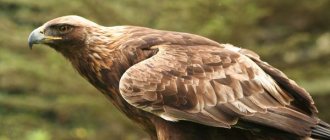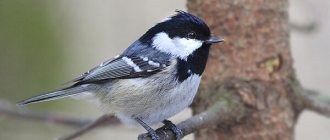- Wild animals
- >>
- Birds
The golden eagle is a bird that represents the genus of eagles.
It is considered one of the largest representatives of this genus. It is distinguished from other birds not only by its impressive size, but also by its specific color, which is characteristic only of golden eagles. This majestic, powerful bird easily adapts to any conditions and can exist in almost any area. However, it is almost impossible to see her in her natural habitat, since she is intelligent and cunning and avoids meeting people in every possible way. Over time, there are fewer and fewer golden eagles. This is a bird species whose numbers are under threat.
Description, structure, characteristics
The golden eagle is a bird of prey, wild and very hardy, with a proud eagle-like posture, which is not surprising, because according to the zoological classification it belongs to the hawk family and the genus of eagles.
The average size of a golden eagle is 70-90 cm, with a wingspan of 180-250 cm. Interestingly, the female golden eagle is several times larger than the male. So the weight of a female reaches 7 kg, while male golden eagles weigh 3-5 kg.
The characteristic eagle's hook-shaped beak, with its sharp end curved down, is one of the iconic differences of this bird. The golden eagle also has slightly elongated feathers on the neck. In general, the golden eagle's body is strong and powerful, its wings are long and wide. In addition, young golden eagles are distinguished by a special bend in their wings; they are narrowed at the base and have an S-like shape. Therefore, it is not surprising that these birds are excellent flyers; the flight speed of a golden eagle in a diving flight can reach 320 km per hour.
The golden eagle's tail is somewhat longer and rounder at the end than that of other eagles, and in this way it is more similar to the tail of the golden eagle's relative -
hawks, however, unlike hawks' tails, the tails of golden eagles open wide like a fan during flight.
The golden eagle's eyes are dark brown, its beak is brown, and its legs are bright yellow.
The voice of golden eagles is somewhat reminiscent of the barking of a dog, but in general it is typical of eagles - ringing. In general, the golden eagle is a taciturn bird, calling only during the mating flight, communicating with chicks and defending its territory.
As for the color of this bird, adult golden eagles are usually brown or black-brown in color with golden feathers on the back of the head. At the same time, males and females have the same color, but it differs in young and older golden eagles, so young birds are almost black, but with pronounced white spots on the underside of the wings. With age and in the process of molting, young golden eagles gradually acquire a more “adult” color (with shades of brown and black), which is finally fixed by the age of 4-5 years.
Interesting fact: according to
ornithologists, white spots on the wings of young birds indicate their youth and, therefore, inexperience. They give them, a kind of indulgence, to hunt on someone else’s territory, belonging to one or another already adult golden eagle.
Nutrition
The golden eagle is a bird of prey and therefore its main diet is various small animals, usually various rodents: field mice, rats, gophers, ferrets, hares, martens, squirrels. Sometimes large golden eagles attack even such large animals as
foxes, fawns, calves and even sheep. They are not averse to feasting on other smaller birds, such as pigeons, ducks, herons, partridges, owls, and geese.
Interestingly, the daily food requirement of a golden eagle is 1.5 kg of meat. In this case, he can fast for up to 5 weeks.
Osprey
This is also an extremely rare species of feathered predator, although these winged creatures can be found in various areas of the planet, although not often. Like the white-tails described above, ospreys are also large and take root well near clean bodies of water, where they feed on fish.
They track it, rising high above the surface of the water, and then dive into the depths, catching prey upon subsequent takeoff. The catastrophic decline in the number of such birds is greatly facilitated by the disgusting ecology and the activities of poachers.
Sources
- https://givotniymir.ru/berkut-ptica-obraz-zhizni-i-sreda-obitaniya-berkuta/
- https://greenparkomsk.ru/pitomcy-popugai/berkut-vikipediya.html
- https://vihuhol.ru/pernatye/berkut-ptica.html
- https://komotoz.ru/photo/zhivotnye/berkut.php
- https://givotniymir.ru/hischnye-ptitsy-nazvaniya-opisanie-klassifikatsiya-i-foto-hischnyh-ptits/
Hunting
The hunting pattern of the golden eagle depends on weather conditions. So, in clear weather, the golden eagle will soar in the heights, looking for prey with its keen gaze, and when one appears in its field of vision, the golden eagle quickly dives, grabs the victim with its tenacious claws, breaks the spine or hits with its sharp beak, tearing blood vessels, and carries the already dead one into your nest. In cloudy weather, the golden eagle will wait for its prey in ambush sitting on the treetops. And again, when suitable prey appears nearby, he acts according to the same algorithm - a rapid throw, grabbing, and so on...
Types, photos and names
There are 6 main subspecies of golden eagles, which differ in feather color and size; below are some of them.
Canadian golden eagle
Lives in North America, USA and Canada.
Central Asian golden eagle
This golden eagle, which lives in the mountains of central Asia, is distinguished by its distinct dark feather color and black “cap”. The feathers on the back of his head are brown, not golden.
Southern European golden eagle
This subspecies of golden eagle lives in the mountains of Southern Europe from Spain to the Caucasus. Found also in our Carpathians. Its color is slightly lighter than that of other golden eagles, and it has a clearly visible “cap” on its head.
Interesting facts about the bird
- The golden eagle is a rare bird in most regions of the world, more or less surviving only in the mountains, treeless tundra and steppes. The total population of this species in the world today is about 170,000 individuals. However, taking into account all the protective measures and special laws to protect these birds, today the golden eagles population as a whole is stable.
- The nomadic peoples of Central Asia, the Kazakhs, Kyrgyz and Mongols, used the golden eagle as a bird of prey to hunt foxes, hares, wolves, saigas and goitered gazelles.
- The bird's name "Golden Eagle" is often used to refer to various military and scientific installations. For example, the Russian Su-47 fighter is known by this name "Berkut". Under the same name, a space suit was developed in the USSR. The special police units at the regional departments of the Ministry of Internal Affairs of Ukraine were officially called “Berkut” until February 2014. Since 2014, the Colombian football club (city of Pereira) has been called “Aguilas Doradas”, which is translated from Spanish as “Golden Eagles” or “Golden Eagles”.
Reproduction of golden eagles
Golden eagles are monogamous birds; they remain marital fidelity throughout their lives, as long as their mating partner is alive. It is interesting that each pair of golden eagles usually has 2-4 nests in different places, where they alternately fly at different times of the year.
The mating season for golden eagles occurs from February to April, at which time males make special demonstrative flights in front of females: wanting to impress their chosen one, they perform various aerial aerobatic maneuvers. This could be, for example, a wave-like flight, when the golden eagle first gains altitude and then rapidly dives down, at the lowest point gaining altitude again and so on in a circle.
The female lays eggs in mid-April, with approximately 1-3 eggs in one clutch. The male and female incubate them alternately for 45 days. Then the chicks are born, while they are little, the mother feeds them, and the father brings prey. Little golden eagle chicks develop and grow very quickly, and after about six months they separate from their parents.
Lifestyle
The golden eagle is a free bird, so birds predominantly choose flat or mountainous areas, steppes, and canyons that are remote from humans. They prefer to nest along rivers and lakes, as well as in foothill areas at an altitude of over 2,000 meters.
Because predators have large wingspans, they need open spaces to stalk prey. In order to rest, golden eagles choose trees that grow on distant rocks or ledges.
Birds live in almost all regions of Russia, but they try to colonize territories that are far away from people, so it is almost impossible to see them in populated areas.
Since humans have left almost no place for the predator on the flat terrain, the golden eagle settles in the swamps of Estonia, Belarus, Lithuania, Latvia, Norway, Sweden, and Denmark. Birds aggressively defend their territory, building nests at a distance of no closer than 10 km to each other. It is known that golden eagles love solitude and peace, so nesting of these birds is practically never found near even the smallest villages.
Captivity
Since ancient times, people have tamed this bird of prey as an assistant in hunting. And although keeping golden eagles in captivity is not a simple matter, nevertheless, an unforgettable hunt with their participation compensates for the trouble. Young birds are usually chosen for training, gradually taming them. So the hunter puts on a leather glove, puts the golden eagle on it and rides around the city with it, this is done so that the bird gets used to the voice and sight of people.
At the same time, the golden eagle is limited in food; it is fed every other day, while at the same time poisoning it against a stuffed animal.
Habitat
This species of bird prefers mountainous areas, but it also feels great on the plains. They build nests far from farmland, as they see humans as a potential threat, both to themselves and to their offspring.
The golden eagle leads a sedentary lifestyle, living in pairs. Some individuals prefer to fly to the highlands in snowy places. They nest mainly on rocky terrain or in trees with difficult accessibility, both for people and other birds of prey.
Over the past few centuries, the bird has significantly reduced its habitat. For reasons related to the agro-industrial sector of some countries, virgin fields are constantly being cultivated, thereby forcing the bird of prey to wander from one settled habitat to another.
There is another global reason - the extermination of the golden eagle by the local population. At the moment, the golden eagle bird is under state protection.
Video
And in conclusion, we invite you to listen to what a golden eagle sounds like.
Author: Pavel Chaika, editor-in-chief of Poznavaika magazine
When writing the article, I tried to make it as interesting, useful and high-quality as possible. I would be grateful for any feedback and constructive criticism in the form of comments on the article. You can also write your wish/question/suggestion to my email [email protected] or Facebook, with respect, the author.
Author page
This article is available in English -
Golden Eagle.
Spreading
The golden eagle is very widespread, but everywhere it is rare and few in number. It lives in Eurasia from the forest-tundra to the Himalayas and Arabia, in North Africa and most of North America. The golden eagle prefers mountains as a nesting habitat (at an altitude of more than 5500 m), but also settles in the foothills, in forests of various types, in the tundra, and in the steppes. Adult birds are sedentary throughout most of their range, while young birds are more prone to migration and migration.











